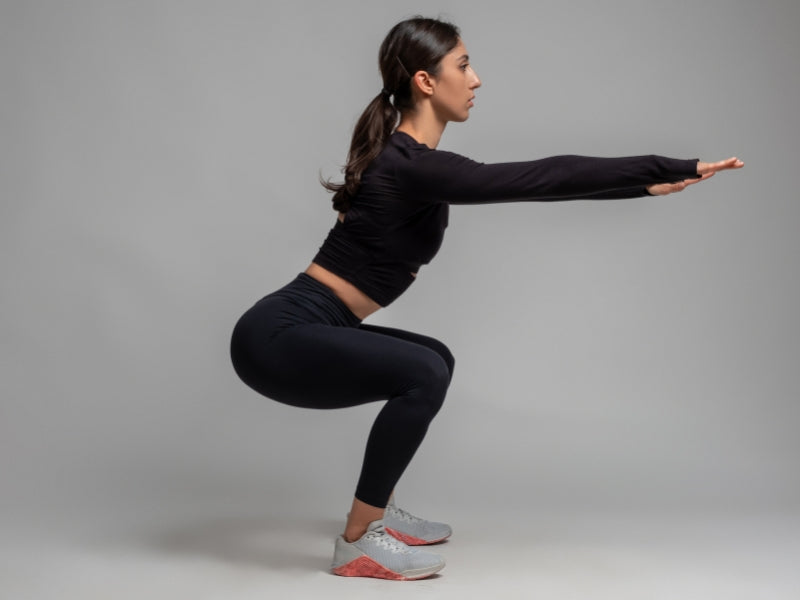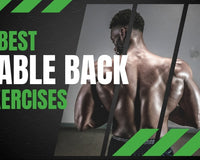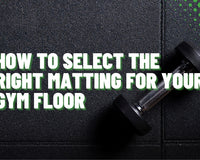If you're looking to develop your quadriceps and overall leg strength, the leg extension machine will be an important training tool at the gym.
However, you might not have access to a leg extension machine. Maybe they're always taken at the gym or maybe you just don't have time to go.
For this reason, you might be looking for some leg extension alternatives, and that's exactly what we're here to look at today.
What is the Leg Extension Machine?

The leg extension machine is very simple, and for the most part, it's exactly what it sounds like. It has you sitting in a seat, with your back vertical against a backrest. Your knees are bent, with your upper legs parallel to the ground, and your lower legs perpendicular to the ground, complete with a pad in front of your ankles or shins.
The point is to push the pad upwards by bending at the knees, thus extending your legs, and ultimately straightening them in the process so that your whole leg, from toe to hip, is parallel with the ground.
You hold this position for a few seconds, and then slowly go back to the starting position. As you can see, it's a very simple exercise.
What Muscles Does the Leg Extension Work?
The leg extension machine focuses on one specific muscle, or muscle group to be precise, the quadriceps.
To be clear, there are four main parts of the quadriceps, including the rectus femoris, the vastus lateralis, the vastus medialis, and the vastus intermedius.
These four sections of the quadriceps make up the vast majority of your front upper leg, and these muscles are extremely important for a variety of reasons, as you'll see directly below.
See our guide for a more detailed breakdown of what muscles leg extensions work and how you can focus or certain parts of your quads.
The Benefits of the Leg Extension Machine

The number one benefit of the leg extension machine is of course that it targets the quadriceps, perhaps better than any other machine or exercise could. This is mainly because it isolates your quadriceps muscles, ensuring you don't work out anything but those exact muscles.
Leg extension machines also allow you to add a good deal of weight to the equation, therefore allowing you to engage in steady progressive overload, and ultimately in muscle growth. The bottom line is that the leg extension is one of the best out there as far as growing quadriceps size and strength are concerned.
Having strong quadriceps is important for a variety of reasons, with one of them being that you need them for pushing motions. Whether you're running, jumping, standing up, or anything in between, it's your quadriceps doing all the work. Without strong quadriceps, your legs will get tired quickly when you're in an upright position.
However, strong quadriceps aren't just about strength per se, but also balance and flexibility. The leg extension machine helps to maintain good flexibility in your knees, which combined with increased leg strength, helps you maintain mobility and balance.
Being both flexible and strong is important as far as balance is concerned. What it really comes down to is that anything that involves you being upright requires well-developed quadriceps muscles.
The Best Leg Extension Alternatives
What we are here to talk about today primarily are alternatives to the leg extension machine. What you might be wondering however is why you would choose an alternative in the first place. Well, the most obvious reason is that leg extension machines are expensive and usually only found at commercial gyms.
They aren't commonly found in home gyms but even if you do go to the gym, there are usually only a few of these machines, and they're usually always taken.
Therefore, having alternative leg exercise machines, body weight exercises, and other leg extension alternatives in your arsenal is always a good idea.
The number one goal to keep in mind when choosing any alternative to the leg extension is that the exercise in question needs to work your quadriceps muscles.
1. Dumbbell Leg Extension
One of the best leg extension alternatives is the dumbbell leg extension. Now, this one requires you to have an adjustable weight bench, along with a dumbbell. It's a good quadriceps exercise if the leg extension machine is already taken, especially if you want to add a certain challenge to the mix.
This exercise requires great balance so you don't fall off the bench, which means that it also helps activate various stabilizer muscles. It requires you to engage your core to a high degree, therefore making it a great compound exercise. Furthermore, you're also using those adductor muscles to hold the dumbbell right in between your feet.
How to do the Dumbbell Leg Extension
- Adjust to the bench so that the backrest is tilted slightly upwards, somewhere in between being flat and the 45° angle. You're going to sit on the backrest, with your legs extending past the headrest. Yes, you're sitting on this machine backwards, with your butt on the backrest. You need to make sure that when you bend your legs down, your heels can't touch the ground.
- Take a dumbbell and place it in between your feet. If this is your first time doing the exercise, we recommend starting with a very light dumbbell. Hold the dumbbell in place by squeezing your feet together.
- For a bit of added support, use your hands to hold the side of the bench, and then straighten your legs until they're fully extended and parallel with the ground.
- Hold this position for a few seconds, and then slowly lower the weight down by bending at the knees until your lower leg is perpendicular with the ground.
- To add more difficulty to this exercise, increase the weight of the dumbbell and increase the amount of time you hold the exercise at the top of the motion.
2. Squats

If you're looking to target your quadriceps muscles, but you don't want to have to use a machine, doing squats is a good option. Squats are great because you can do them without any equipment at all.
However, you can also add difficulty to the equation by placing resistance bands around your upper legs, by holding dumbbells in your hands, or by doing a weighted squat with a barbell on your upper back. Whatever the case may be, squats can be done virtually anywhere, and this is something that makes them so appealing.
Furthermore, they're also a low-impact exercise, not to mention that they also do a fantastic job at targeting your quadriceps. However, instead of just targeting your quadriceps, the squat also targets your hamstrings and your glutes, which brings added benefits.
How to Squat
- To squat, start by standing with your feet at hip width or shoulder width apart, depending on your skill level and what's more comfortable for you.
- If you have trouble balancing, you can clasp your hands in front of you, hold them out in front, or to your sides, whatever feels best for you.
- Slowly bend your knees and lower your buttocks to the ground, while keeping your hips back, your back straight, and your chest forward.
- Lower yourself down until your thighs are parallel with the ground, or as close to that as you can get.
- Hold this position for one or two seconds, and then push your heels down into the ground and extend your legs until you're back up in the starting position.
Related Exercise: Smith Machine Squat Exercise Guide
3. Reverse Prowler Push
The reverse prowler push is one of the more interesting exercises on the list today, and it's one of the most difficult ones as well. It closely mimics the mechanics of the leg extension machine, all without the need for the machine itself.
In fact, it's one of the best quadriceps-building exercises out there, as long as you have a prowler or a weight sled. That said, not every gym has weight sleds or prowlers, so you'll have to find one that does, or also buy one for use at home, which requires you to have a good deal of space.
How to Do the Reverse Prowler Push
- Start by taking weight plates and loading them onto the weight sled or prowler, starting with a relatively low weight, just to see how the movement feels.
- Start by facing away from the prowler with your back against its handles, making sure that your core is engaged and your back is straight. Proper form is essential during this exercise.
- While keeping your core engaged and your back straight, push the prowler backwards by using your legs, and go for a predetermined distance.
- If that's not hard enough for you, you can always turn it around and push the prowler back to the starting position, or increase the amount of weight.
- If you're looking to build leg endurance, use a lighter weight over longer distances, and if you're looking to build massive quadriceps, go shorter distances with heavier weights.
4. Cable Kicks AKA Cable Leg Extension
If you're looking for an exercise that puts constant tension on your quadriceps, you might want to try doing a cable leg extension, otherwise known as a cable kick. This exercise requires you to have access to a cable machine that allows you to adjust the pulley to.
Here, you also need to have an ankle strap so you can attach your leg to the pulley. It's a great exercise, because the constant tension on your quadriceps means that you have to fight for every single rep no matter what stage of the exercise you are in.
How to do Cable Leg Extensions
- Start by moving the pulley of the cable machine to the low position and then choose the amount of weight you want to start with. As is the case with any exercise, we recommend starting with a relatively low weight, just so you can get proper form and technique down first.
- Attach the ankle strap to the pulley machine, and secure it around your ankle. Make sure that it is relatively tight, so it stays in place.
- If you're working your right leg first, stand beside the pulley machine and plant your left leg firmly on the ground. Seeing as you'll be standing on one leg while pushing with the other, it's helpful if you hold on to the pulley machine for balance with your left hand.
- While holding on to the cable machine and with your left leg planted firmly on the ground, raise your right leg up slightly so that your foot is no longer on the ground.
- With your foot slightly raised up, push your foot forward as far as you can until your leg is as close to being fully extended as possible. Hold this position for a second or two, and then return to the starting point. Important is that your thigh or upper leg stays stationary while you do this. All of the motion should be in your lower leg.
5. Wall Sits

If you want to do a great quadriceps exercise, and you don't even want to do any moving, then the wall sit is a great exercise to consider. The wall sit is known as an isometric leg exercise, which means that it works your muscles without any actual movement.
All you do is take a seated position and sit against a wall for as long as you can. It's great for targeting your quadriceps, and it's also beneficial because you can do it anywhere as long as you have access to a wall.
How to do the Wall Sit
- Start by standing against a wall, with your back flat against it, your feet at shoulder width, and your toes pointing outwards just a little bit.
- Bend at the hips and knees to lower your body down until you're in a sitting position. Imagine yourself sitting in a chair. Your knees should be at a 90° angle, and right above your ankles. Your back should not arch and should remain flat against the wall.
- To help maintain stability during the exercise, engage your core muscles.
- Sit against the wall as long as you can, until your quads burn so bad that you feel like collapsing.
- Once you're done, slowly stand back up, or if your quadriceps are really tired, you might just want to sit down.
Related: What muscles are worked by Burpees?
Final Thoughts
As you can see, there are plenty of great leg extension alternatives out there, exercises that target your quadriceps. Whether you're using a cable machine, doing wall sits, a bench and dumbbells, or anything in between, there are plenty of great exercises to grow those quadriceps into something worth looking at. Remember, consistency is key, so don't give up!





